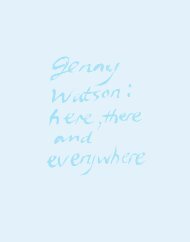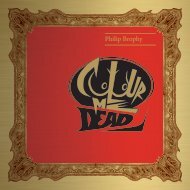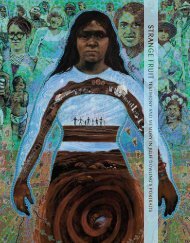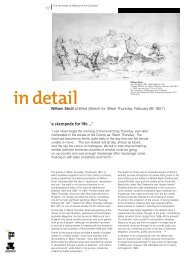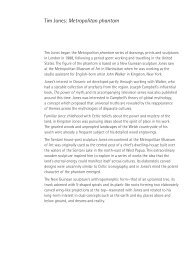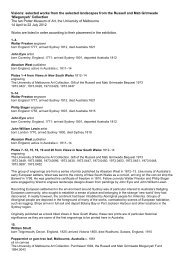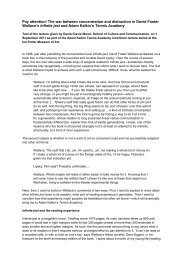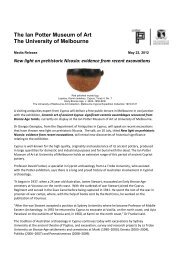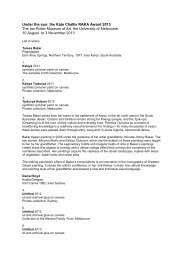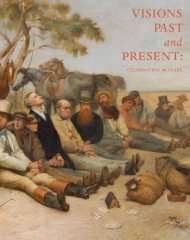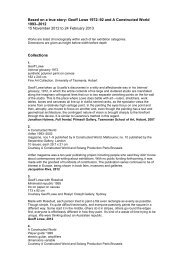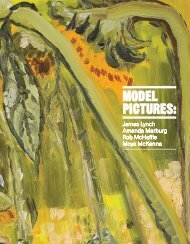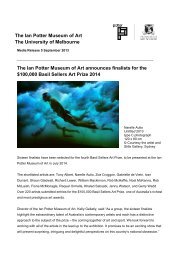The drowned world Jon Cattapan works and collaborations
Catalogue - Ian Potter Museum of Art - University of Melbourne
Catalogue - Ian Potter Museum of Art - University of Melbourne
- No tags were found...
Create successful ePaper yourself
Turn your PDF publications into a flip-book with our unique Google optimized e-Paper software.
Cat. 63 Red system no. 1 (<strong>The</strong> first deadly system) 1997–98<br />
Nicholson: <strong>The</strong> screen metaphor refers to a system of<br />
representation other than painting: a pixel-based system<br />
which articulates every part of its surface equally. In Red<br />
system no. 1 (<strong>The</strong> first deadly system) [1997–98], those<br />
pixels constitute an illusion of a space or a l<strong>and</strong>scape.<br />
Swinging back <strong>and</strong> forward between that data <strong>and</strong> what<br />
lies underneath makes you think of a screen.<br />
Healy: I don’t buy the data metaphor because to me the<br />
reference point for the dots was light. In Woden waiting<br />
[1992–93], because it’s a night-time image in which the<br />
light was constituting the city, there’s the idea that there’s<br />
light coming through tears or perforations. It’s a much<br />
stronger metaphor for me than data drizzling down Matrixlike.<br />
I think there are many other ways of thinking about<br />
abstraction other than simply ones <strong>and</strong> zeros.<br />
Nicholson: For me, they suggest a certain kind of vision<br />
which is totally separated from touch. <strong>The</strong>re’s a very strong<br />
implication that you’re encountering the city as you do<br />
from an aeroplane. At the same time, you’re also aware of<br />
<strong>Jon</strong> making fingerprints with a paintbrush. So the paintings<br />
play on a tension between something tactile <strong>and</strong> sight<br />
utterly removed from that sense.<br />
Healy: Karen, given your background in architecture, do<br />
you think it’s the vision of the urban planner? Some writers<br />
describe <strong>Jon</strong> as a flâneur, involved in the poetics of<br />
walking, which is exactly the opposite of that perspective.<br />
Burns: Even though we’re located with a view from the<br />
tower, because we’re actually dealing with the gestural<br />
activity of mark-making <strong>and</strong> a very expressionist technique<br />
in the background, we’re confronted with the human<br />
immediacy of the tactile mark on the canvas.<br />
<strong>Cattapan</strong>: For me, <strong>The</strong> group discusses is like the city in<br />
microcosm, whereas Red system no. 1 is a very experiential<br />
work. It was made not that long after coming back from<br />
India. Very often for me being in a particular place is about<br />
an evocation of colour. <strong>The</strong> only way I could describe Seoul<br />
is that it was a blue sort of city. India was a very red place.<br />
Over there, colour <strong>and</strong> smell were just absolutely<br />
overwhelming sensations <strong>and</strong> I wanted to work back into<br />
that as a bodily thing, whilst at the same time continuing<br />
to talk about the urban overlay.<br />
Nicholson: <strong>The</strong> point of view in Red system no. 1 is very<br />
evocative of weightlessness; there’s not any place in the<br />
picture where your body would feel whole or subject to<br />
gravity. <strong>The</strong> taking of Richmond [1999] relates to disputes<br />
<strong>and</strong> pickets in the Kennett years; in the picture the weight<br />
of the body is a kind of political instrument. <strong>The</strong>re’s a very<br />
interesting tension between that picture <strong>and</strong> other images<br />
where the body is almost a dispersed entity.



